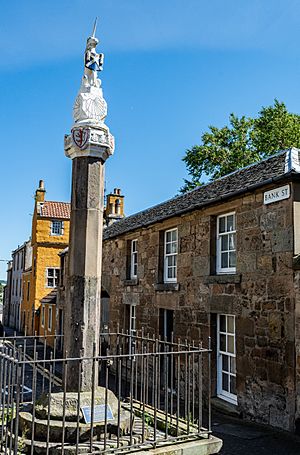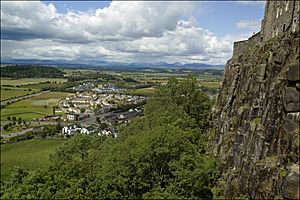John Mosman (apothecary) facts for kids
John Mosman was an apothecary (like a pharmacist) who worked for the Scottish royal family. He served King James IV of Scotland and his wife, Queen Margaret Tudor. Mosman provided medicines, spices, herbal remedies, and medical treatments for the royal household.

Contents
Family Connections
Other members of John Mosman's family were skilled goldsmiths. One relative, also named John Mosman, worked for King James V. His son, James Mosman, built a famous house in Edinburgh known today as the "John Knox House". Some people believe the Mosman family might have had Jewish roots. Records from 1490 show a John Mosman and his son Robert living on lands called "Easter Gledstanis".
His Career as an Apothecary
By 1513, John Mosman received a regular payment of £10 from the royal treasurer. Around 1507, official court records listed him and William Foular as the court's "pottingaris." This was an old Scots language word for an apothecary.
The Royal Wedding
In April 1503, Mosman traveled to Flanders to buy special materials for the king. These supplies might have been for the upcoming royal wedding. John Mosman provided a sweet, spiced wine called "Hippocras" at the wedding of James IV and Margaret Tudor. This grand event took place at Holyrood Palace in Edinburgh. The wine cost 18 Scottish shillings. An English official, John Young, who wrote about the queen's journey, noted that there was "plenty of Ypocras" shared among the 41 men King James IV knighted for the queen.
Healing and Medical Care
In November 1505, there was a worry about the plague in Dunfermline. Queen Margaret Tudor was staying at Dunfermline Palace at the time. Mosman took care of four African people, known as the "More lasses," who probably included Ellen More. He looked after them in North Queensferry and Inverkeithing.
In August 1505, Mosman helped heal the arm of Elizabeth Barlay. She was an English lady-in-waiting to Queen Margaret who later married Lord Elphinstone. Mosman was paid 14 shillings for his travel to Edinburgh "to mak potingary for Mastres Barleis arme" (to make medicine for Mistress Barlay's arm).
On September 13, 1505, Mosman received glass jugs and urinals, which were common medical tools. He went to Stirling Castle in November to get a rare imported "must cat" (a type of civet cat). In June 1513, he sent spices to Queen Margaret Tudor at Linlithgow Palace.
The Fifth Element Project
John Mosman was also involved in a special project for the king. King James IV wanted to find the "fifth element" or "quinta essentia." This was an imagined healing substance. They used furnaces at Holyrood Palace and Stirling Castle for this work. Mosman supplied materials to the alchemists (people who tried to turn ordinary metals into gold or find magical substances) in January 1508. In January 1513, he was given a gold coin (a crown weight) for the "quintessence" project.
Other alchemists at Stirling Castle included Caldwell, Valentine McLellane, and an Italian named John Damian. Damian is famous for trying to fly, which was even written about in a poem by William Dunbar. The royal records show payments to Mosman for building furnaces in December 1503 and for bellows (tools used to blow air into a fire).
The "quintessence" was thought to be a powerful healing substance, similar to distilled alcohol or "aqua vitae" (water of life). King James IV's interest in these furnaces might have been a way to show his people that he was a successful ruler. It suggested he had control over both natural and supernatural forces.
The idea of the "quintessence" was well-known in the 1500s. In England, King Henry VII was also interested in alchemy. He rewarded a visitor from Perpignan who "shewed quinta essentia" in 1499. He also hired someone to try and make gold in the Tower of London. Later, in 1586, Queen Elizabeth joked about King James VI making a "quintessence of some humours" (a strong, sour liquid) because he jumped to conclusions.
The exact dates of John Mosman's birth and death are not known.
Other Apothecaries in Scotland

Another important apothecary was William Foular. He also served Queen Margaret Tudor. When she had nosebleeds, Foular provided a special stone called a blood stone or heliotrope to help. Foular also sent the queen medicinal spices like pepper, cinnamon, "cubebarum" (cubeb berries), and "galiga" (galangal root), along with glass urinals. He even made sweet citron candies for the king. Foular received a regular payment of 20 merks from Edinburgh's customs duties. He was also excused from regular city duties because of his royal service.
In the 1590s, the Scottish court was served by another apothecary named Alexander Barclay.

